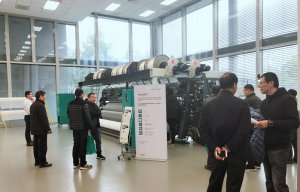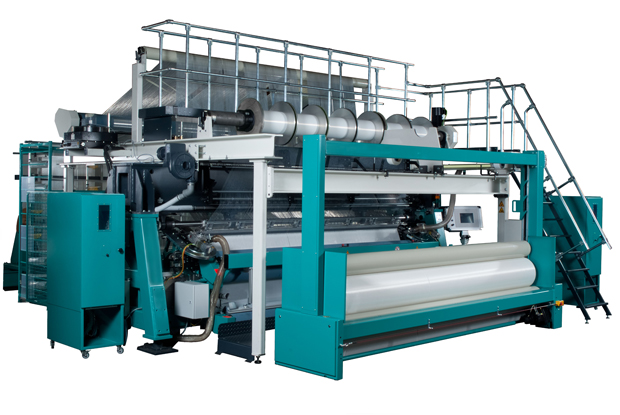
Karl Mayer launches TM Weft in China
Karl Mayer Malimo has introduced two new working widths for its Wefttronic RS parallel weft insertion machines. A Wefttronic RS in a width of 213 inches was shown at the recent ITMA ASIA + CITME in Shanghai and a 176 inch machine was introduced at the same time.

5th July 2012
Innovation in Textiles
|
Shanghai
Karl Mayer Malimo has introduced two new working widths for its Wefttronic RS parallel weft insertion machines. A Wefttronic RS in a width of 213 inches was shown at the recent ITMA ASIA + CITME in Shanghai and a 176 inch machine was introduced at the same time.
For some time now, raschel machines with parallel weft insertion have been among Karl Mayer Malimo’s best-selling machines. The machines mainly process high-strength polyester yarns to produce straight weft and zero inlays in 90° and 0° layers using three guide bars, and in some cases two guide bars for special applications.
In parallel weft insertion fabrics, the horizontal and vertical load-bearing yarns are fixed in line with the construction by the front guide bars. Products having a high tenacity and tear propagation resistance are mainly produced, and fabrics with special characteristics can also be manufactured.

The fabrics may have dense constructions as well as lattice constructions with specific opening widths, and can have a range of weights from light to medium weight, depending on the requirements of the end-use.
The main end-uses of weft-insertion fabrics, which come in a variety of designs, are as advertising substrates and print grounds, tarpaulins, protective textiles, awnings, abrasive fabrics and plaster grids.
According to Karl Mayer, competition is fierce in markets for stable weft insertion fabrics and any manufacturer who wants to be successful, needs production machines which combine an exceptional price:performance ratio with high product quality, are easy to operate, and offer a sufficient level of flexibility thanks to their different working widths.
These requirements spurred Karl Mayer Malimo on to develop a completely new basic concept for its parallel weft insertion raschel machines and the result of the extensive development work was the Wefttronic RS, which was unveiled for the first time at ITMA ASIA + CITME 2010. The Wefttronic RS’ working width has been constantly expanded since then.
The modifications in the construction, which led to the development of the Wefttronic RS, focused mainly on increasing the speed and productivity of the machine and consequently, the entire machine space and basic construction were adapted to the higher dynamics of the warp knitting process in order to increase the speed.
In addition to increasing the production speed, the working width was also extended, which enabled performance to be increased by up to 20%.
Another improvement in efficiency offered by the new weft-insertion machine has been achieved by improving the components used in weft insertion. For example, the guide system of the circulating chain has been re-designed, and the weft insertion system has been optimised. The weft carriage now contains 30 yarns instead of the previous 24.
The modified weft insertion system, with its ½-inch spacing, is also said to guarantee fault-free yarn laying without the yarns sticking together, which also increases the product quality.
In order to produce a perfect fabric, Karl Mayer says, the entire yarn handling sequence on the machine was analysed and improved. These changes in the construction are said to have resulted in uniform zero inlay run-ins in the delivery unit and at the guide rollers, thanks to central supports and short yarn paths for the knitting yarns in the ground guide bars.
Recent developments have concentrated on complementing the range of working widths available. Whereas the first Wefttronic machine, which appeared in 2010, had a width of 268 inches, a version with a width of 138 inches was already available for ShanghaiTex 2011.
A Wefttronic RS in a width of 213 inches was exhibited at ITMA Asia 2012 – an intermediate width which was complemented by a machine with a width of 176 inches, launched at the same time.
The Wefttronic machine on show in Shanghai was labelled Wefttronic RS 2 and was producing a billboard coating substrate in gauge E18 on a 213 inch working width. Production data quoted for the machine was a running speed of 1700 rpm, 3.54 courses per centimetre at take-up and an output of 1500 square metres per hour.
According to Karl Mayer, the different working widths of the Wefttronic RS for the simultaneous production of several fabric webs next to each other can be fully utilised to achieve a high level of operating efficiency.
All the technical features of the Wefttronic RS are housed in a space-saving machine configuration. The compact construction aims to minimise floor space requirements and the ergonomic design is said to promote easy operation.
Touchscreens for man:machine communication, the location of the ladder on the right-hand side of the machine, the drive, the patterning mechanism, and optimum width adjustment by a maximum of 60 inches round off the package of features that minimise the time and effort involved in operating the machine, Karl Mayer explains.
The Wefttronic RS can be integrated into the company’s own network or linked to the Internet to simplify data transfer and linking the machine to the worldwide web enables Karl Mayer’s Teleservice Plus to be accessed. Among other things, Karl Mayer says, this service speeds up fault analysis and communication, and enables the service centre to access the machine on-site in real time.

Business intelligence for the fibre, textiles and apparel industries: technologies, innovations, markets, investments, trade policy, sourcing, strategy...
Find out more